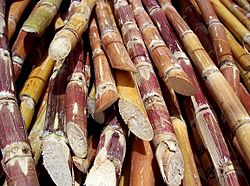Sugarcane facts for kids
Quick facts for kids Sugar Cane |
|
|---|---|
 |
|
| Sugarcane cut | |
| Scientific classification | |
| Kingdom: | |
| Division: | |
| Class: | |
| Order: | |
| Family: | |
| Genus: |
Saccharum
|
Sugarcane is a type of plant that looks like a tall grass. There are many different kinds, or types, of sugarcane. It grows best in warm, tropical places. Sugarcane first grew in Asia. After the year 700, people started planting it in Africa and southern Europe. Later, it spread to the Americas and Australia. Today, Brazil in South America grows the most sugarcane.
Sugarcane stalks can grow very tall, from 2 to 6 metres high. These stalks are full of sugar, which is used to make food and drinks sweet. After the sugar is taken out, the leftover stalks can be burned to create heat and electricity. They can also be made into paper, cardboard, and even cutlery. This plant needs high temperatures and lots of rain. If there isn't enough rain, farmers use irrigation to water the crops. Black soil or alluvial soil is best for growing sugarcane. It needs a lot of water, so deep soil that can hold water is important. Farmers also use compost and chemical fertilizers because sugarcane uses many nutrients from the soil.
Growing Sugarcane

Sugarcane needs a tropical or subtropical climate to grow well. It needs at least 60 centimetres (24 inches) of rain each year. Sugarcane is one of the most efficient photosynthesizers in the plant kingdom. This means it is very good at turning sunlight into energy and growth. It's a special type of plant called a C4 plant, which helps it grow quickly. In good growing areas like Mauritius, Brazil, and Australia, sugarcane crops can produce a lot of cane.
Most of the world's sugarcane grows between 22°N and 22°S of the equator. Some can grow further north or south, up to 33°N and 33°S, especially if there are warm ocean currents nearby. Sugarcane does not like severe frost. It can also grow at high altitudes, up to 1,600 metres (5,200 feet), near the equator in countries like Colombia.
Sugarcane can grow in many different types of soil. It grows well in rich, well-drained soils, but also in heavy clay soils, less fertile acidic soils, peaty soils, and even rocky soils. Lots of sunshine and water help sugarcane grow bigger. This is why desert countries with good irrigation, like Egypt, can grow a lot of sugarcane.
How Sugarcane Plants Grow
Even though some sugarcane plants produce seeds, most new plants are grown from pieces of the stem. Each piece, called a cutting, must have at least one bud. These cuttings are sometimes planted by hand. In countries with more advanced farming, like the United States and Australia, machines plant the cuttings.
Once planted, a sugarcane field can be harvested many times. After each harvest, the cane grows new stalks, called ratoons. Each new harvest usually produces a little less cane. Farmers typically harvest a field between two and ten times before replanting. In places with large fields and machine harvesting, like North America, sugarcane is replanted after two or three harvests to keep yields high. In places with smaller fields and hand harvesting, like the French island of Réunion, sugarcane might be harvested for up to 10 years before replanting.
Harvesting Sugarcane
Sugarcane is harvested both by hand and by machines. More than half of all sugarcane is still harvested by hand, especially in developing countries. For hand harvesting, farmers sometimes set the field on fire first. This fire burns dry leaves and chases away snakes without harming the main stalks or roots. Workers then cut the cane close to the ground using cane knives or machetes. A skilled worker can cut about 500 kilograms (1,100 pounds) of sugarcane in an hour.
Mechanical harvesting uses a special machine called a sugarcane harvester. These machines cut the cane at the bottom, remove the leaves, chop the cane into pieces, and put it into a truck driving alongside. The machine then blows the leftover leaves back onto the field. These machines can harvest 100 metric tons (220,000 pounds) of cane in an hour. However, harvested sugarcane must be processed quickly because it starts to lose its sugar content after being cut. Mechanical harvesting does not require burning the field. The leftover tops and dead leaves from the machine act as a natural cover for the soil, helping the next crop grow.
Images for kids
-
Sugar plantation in the British colony of Antigua, 1823
-
A sugar plantation on the island of Réunion in the late 19th century
-
Sugarcane flower, Dominica
See also
 In Spanish: Caña de azúcar para niños
In Spanish: Caña de azúcar para niños















